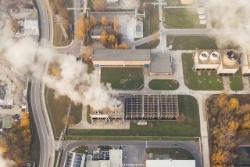Air New Zealand Biofuel Test Flight Underway
Air New Zealand Biofuel Test Flight Underway
The world's first commercial aviation test flight powered by a sustainable second-generation biofuel took-off at 11:30am (NZ time) from Auckland International Airport.
The approximately two-hour test flight is utilising a biofuel blend of 50:50 jatropha and Jet A1 fuel to power one of the Air New Zealand Boeing 747-400's Rolls-Royce RB211 engines.
The test flight is a joint initiative between Air New Zealand, Boeing, Rolls-Royce and Honeywell’s UOP, as part of commercial aviation's drive for more sustainable air travel for future generations.
Air New Zealand Chief Executive Officer Rob Fyfe says the flight is a milestone for the airline and commercial aviation.
“Today we stand at the earliest stages of sustainable fuel development and an important moment in aviation history,” he says.
“Air New Zealand is proud to be playing its role in that journey by being the first to prove the viability of a second generation biofuel such as jatropha.”
Pilot in Command, Air New Zealand 747 Fleet Manager Captain Keith Pattie and his crew are operating the flight predominantly over the wider Hauraki Gulf area.
A number of tests are currently underway at various altitudes and under a variety of operating conditions to measure the biofuel’s performance through the engine and fuel systems.
Air New Zealand Chief Pilot Captain David Morgan, who is onboard the aircraft, says the results from the flight tests will provide the airline and its partners with invaluable data in helping jatropha to become a certified aviation fuel.
“We are undertaking a wide variety of tests under normal and non-normal operating conditions, designed to test the biofuel to the fullest extent,” says Captain Morgan
The tests being conducted include:
• Take off: A full power take off, with throttles advanced as per normal operating conditions, establishing three-quarter power and then to full power.
• Climb: The aircraft climbs to 25,000 feet. At an altitude of 20,000 – 25,000 feet, the main fuel pump for engine one (the engine powered by the biofuel) will be switched off. This will test the lubricity of the fuel, ensuring the friction of the fuel does not slow down its flow to the engine.
• Cruise: Once cruising at 35,000 feet the auto-throttle will be switched off and the crew will manually set all engine controls, so the Engine Pressure Ratios (EPRs) and other engine performance parameters across all four engines can be checked for identical readings.
• Deceleration/acceleration: The crew will control the fuel flow to the engine and measure the rate of change of the engine under these changing operating conditions.
• Descent: Engine one will be shut down at 26,000 feet with a windmilling restart at 300knots. An engine shutdown will take place again at 18,000 feet, this time with a starter-assisted relight at 220 knots.
• Simulated approach and go around: When the aircraft is at 11,000 feet the autopilot will be programmed to land on a runway “located” at 8,000 feet and undertake a missed approach. This is to test the performance of the fuel under maximum thrust.
• Landing: The flight will be completed with a normal landing, including the use of reverse thrust upon touchdown. The aircraft will then taxi back to the hardstand, stop all engines and restart engine one by itself.
The aircraft is expected to touch down back at Auckland International Airport at approximately 1.15pm (NZ time).
ENDS


 MBIE: MBIE Publish Mid-Point Review Of The Phase-Out Of The Low Fixed Charge (LFC)
MBIE: MBIE Publish Mid-Point Review Of The Phase-Out Of The Low Fixed Charge (LFC) Science Media Centre: Company Claims To Have “De-Extincted” The Dire Wolf – Expert Reaction
Science Media Centre: Company Claims To Have “De-Extincted” The Dire Wolf – Expert Reaction Stats NZ: Greenhouse Gas Emissions Fall 2.0 Percent In The December 2024 Quarter
Stats NZ: Greenhouse Gas Emissions Fall 2.0 Percent In The December 2024 Quarter The Reserve Bank of New Zealand: Christian Hawkesby Appointed As Governor Of The RBNZ
The Reserve Bank of New Zealand: Christian Hawkesby Appointed As Governor Of The RBNZ Kiwi Economics: It’s Mayhem In Markets As Downside Risks Dominate Following Trump’s Tariffs
Kiwi Economics: It’s Mayhem In Markets As Downside Risks Dominate Following Trump’s Tariffs Mindful Money: Consumer Demand For Ethical Investing Remains Strong Despite International Headwinds
Mindful Money: Consumer Demand For Ethical Investing Remains Strong Despite International Headwinds



